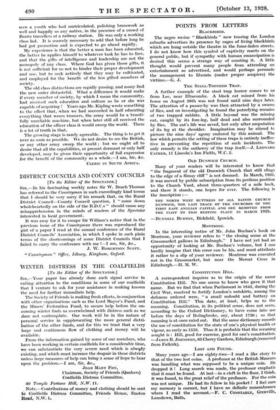POINTS FROM LETTERS
BLACKBIRDS.
The negro review " Blackbirds" now touring the London suburbs advertises its presence by cages of living blackbirds which are hung outside the theatre in the fume-laden streets. I do not know how this symbol of captivity reacts on the general public, but if sympathy with human emancipation is desired this seems a strange way of courting it. A little thought would prevent many people from attending an entertainment so advertised, and would perhaps persuade the management to liberate '(under proper auspices) the victims.—G. J.
THE STEEL-TOOTHED TRAP.
A further example of the steel trap horror comes to us from Lee, near Ilfracombe. A black cat missed from his
home on August 26th was not found until nine days later. The attention of a passer-by was then attracted by a swarm of flies, and on investigating he found the putrefying remains of two trapped rabbits. A little beyond was the missing cat, caught by its fore-leg, half dead and also surrounded by flies. The cat's life was saved, but only after amputation of its leg at the shoulder. Imagination may be stirred to picture the nine days' agony endured by this animal. The law which permits the setting of these traps is entirely ineffec- tive in preventing the repetition of such' incidents. The only remedy is the outlawry of the trap itself.—J. LEONARD CATHER, 11 Lincoln's Inn Fields, W.f. 2.
OLD DUNWICH CHURCH.
Many of your readers will be interested to know that " the fragment of the old Dunwich Church that still clings to the edge of a flimsy cliff " is not doomed. In March, 1923, it was moved by public subscription from its perilous position to the Church Yard, about three-quarters of a mile back, and there it stands, one hopes for ever. The following is the inscription :—
THE NORTH WEST BUTTRESS OF ALL SAINTS CHURCH DUNWICH, THE LAST TRACE OF THE CHURCHES OF THE FIRST EAST ANGLIAN CAPITAL AND SEE REMOVED FROM THE CLIFF TO THIS RESTING PLACE IN MARCH 1923.
—BUNNELL BURTON, Birkfield, Ipswich.
MONTROSE.
In the interesting notice of Mr. John Buchan's book on Montrose, your reviewer refers to " the closing scene at the Grassmarket gallows in Edinburgh." I have not yet had an opportunity of looking at Mr. Buchan's volume, but I can hardly imagine that this error can be his, and must attribute it rather to a slip of your reviewer. Montrose was executed not in the Grassmarket, but near the Mercat Cross in Edinburgh.—H. M. W.
CONSTITUTION HILL.
A correspondent inquires as to the origin of the name Constitution Hill. No one seems to know who gave it that name. But we find that when Parliament in 1642, during the Civil War, resolved to fortify London's outskirts, among the defences ordered were, " a small redoubt and battery on Constitution Hill." This date, at least, helps us to the meaning. Constitution, in its political sense, does not seem, according to the Oxford Dictionary, to have come into use before the days of Bolingbroke, say, about 1730 ; so that meaning is at once ruled out. But the same dictionary records the use of constitution for the state of one's physical health or vigour, as early as 1553. Thus it is probable that the meaning sought is : Hill, good for exercise, good for one's constitution. —JAMES B. JOHNSTON, 63 Cherry Gardens, Edinburgh (removed from Falkirk).
LOST AND FOUND.
Many years ago—I am eighty-two—I read a like story to that of the two lost coins. A professor at the British Museum was handling what was supposed to be a unique coin. He dropped it ! Long search was made, the professor emphatic that it must be found. At last—in a cleft in the floor, I think, it was found, to the great relief of the professor. For the coin was not unique. He had its fellow in his pocket ! I feel sure my memory is correct, but I have no definite remembrance where I read the account.—F. C. CONSTABLE, Grenville. Lansdown, Bath.








































 Previous page
Previous page